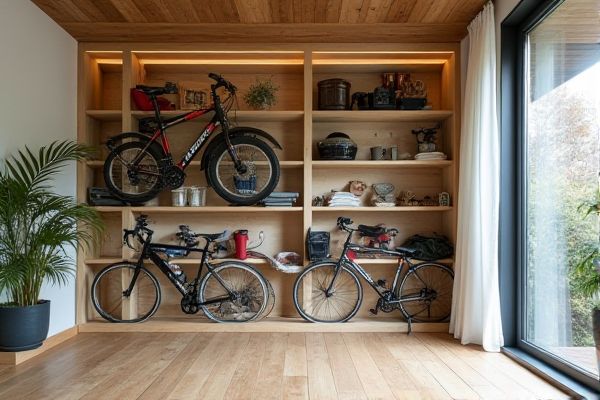
Vertical bike storage maximizes space by allowing your bike to be stored upright against a wall, saving floor space and making it ideal for smaller areas. Explore the rest of the article to discover which storage option best suits your needs and lifestyle.
Table of Comparison
| Feature | Vertical Bike Storage | Horizontal Bike Storage |
|---|---|---|
| Space Efficiency | Maximizes floor space, ideal for small areas | Requires more floor space, better for spacious areas |
| Ease of Access | May require lifting bike, moderate accessibility | Easy to grab and place bike, user-friendly |
| Bike Protection | Less contact points, lower risk of scratches | More contact points, potential frame wear |
| Installation | Wall or ceiling mounting needed, moderate effort | Simple floor racks or hooks, easy installation |
| Number of Bikes | Better for storing multiple bikes vertically | Suitable for fewer bikes due to space limits |
| Cost | Typically lower cost, minimal hardware | Varies, can be higher due to larger racks |
| Best Use Case | Small garages, apartments, limited floor space | Garages, bike shops, wider storage areas |
Overview of Vertical vs Horizontal Bike Storage
Vertical bike storage maximizes space by allowing bikes to be hung upright on walls, making it ideal for small apartments or garages with limited floor area. Horizontal bike storage involves placing bikes side by side on racks or stands, which can accommodate more bikes but requires broader floor space and easier access. Your choice depends on available space, bike accessibility, and storage capacity needs.
Space Efficiency: Vertical vs Horizontal Solutions
Vertical bike storage maximizes floor space by utilizing wall height, enabling multiple bicycles to be stored in compact areas, ideal for small apartments or garages. Horizontal bike racks require more linear floor space, making them less efficient in confined environments but easier for quick access and bike maintenance. Optimizing space efficiency depends on available room dimensions and user preferences for convenience versus storage density.
Installation Requirements and Complexity
Vertical bike storage typically requires mounting a sturdy wall or ceiling bracket, demanding precise measurements and secure anchoring into studs or solid surfaces, which can complicate installation in drywall or brick walls. Horizontal bike storage often involves simpler floor stands or racks that need minimal assembly and no wall modifications, making it easier and faster to install. The complexity of vertical racks increases with weight capacity and spatial constraints, whereas horizontal solutions prioritize accessibility and straightforward setup.
Accessibility and Ease of Use
Vertical bike storage maximizes floor space by suspending bikes on walls, offering quick access for single-bike retrieval but may require lifting heavier bikes, which can be challenging for some users. Horizontal bike storage keeps bikes at ground level, enabling easier mounting and dismounting without the need for lifting, making it more accessible for frequent use and all age groups. Choosing between vertical and horizontal options depends on the balance between space efficiency and user physical capability for optimal accessibility and ease of use.
Suitability for Different Bike Types
Vertical bike storage suits road bikes and lightweight frames due to its space-saving design and ease of access, while horizontal storage better accommodates heavy mountain bikes and bikes with non-standard shapes. Vertical racks often require less floor space but may not support wider tires or full suspension frames effectively. Horizontal storage provides greater stability for varying bike geometries, making it ideal for diverse bike collections.
Aesthetics and Home Integration
Vertical bike storage maximizes space by utilizing wall areas, creating a sleek and modern aesthetic that blends seamlessly with your home decor. Horizontal bike storage offers a more traditional look, often doubling as a display piece when positioned strategically within living spaces. Your choice depends on balancing available space with the desired visual integration to complement your home's style.
Impact on Bike Maintenance and Longevity
Vertical bike storage minimizes contact with the ground and reduces pressure on tires, which helps prevent flat spots and extends tire life. Horizontal storage allows for more balanced weight distribution, reducing stress on the bike frame and components during long-term storage. Choosing the right storage method can directly influence your bike's maintenance needs and overall longevity.
Cost Comparison: Vertical vs Horizontal
Vertical bike storage generally offers a more cost-effective solution due to its space-saving design, requiring less floor area and enabling more efficient use of existing storage rooms or garages. Horizontal bike racks often demand more extensive wall or floor space, potentially increasing installation and material expenses, especially in smaller areas. Choosing vertical storage reduces the need for large rooms and costly structural modifications, making it a budget-friendly option for maximizing bike storage capacity.
Safety and Stability Considerations
Vertical bike storage maximizes space but requires secure wall anchors to prevent bikes from tipping or falling, ensuring safety and stability. Horizontal storage offers more stable support by evenly distributing weight, reducing the risk of damage or accidents. Choose the option that best fits your space and guarantees your bike stays secure and protected.
Choosing the Right Bike Storage for Your Needs
Vertical bike storage maximizes floor space by allowing Your bike to hang upright against a wall, ideal for tight spaces and easy access. Horizontal storage, which involves mounting the bike parallel to the wall or laying it flat, offers greater stability and minimizes pressure on the tires and frame. Choosing the right bike storage depends on your available space, frequency of use, and desire for convenience or protection.
 homyna.com
homyna.com